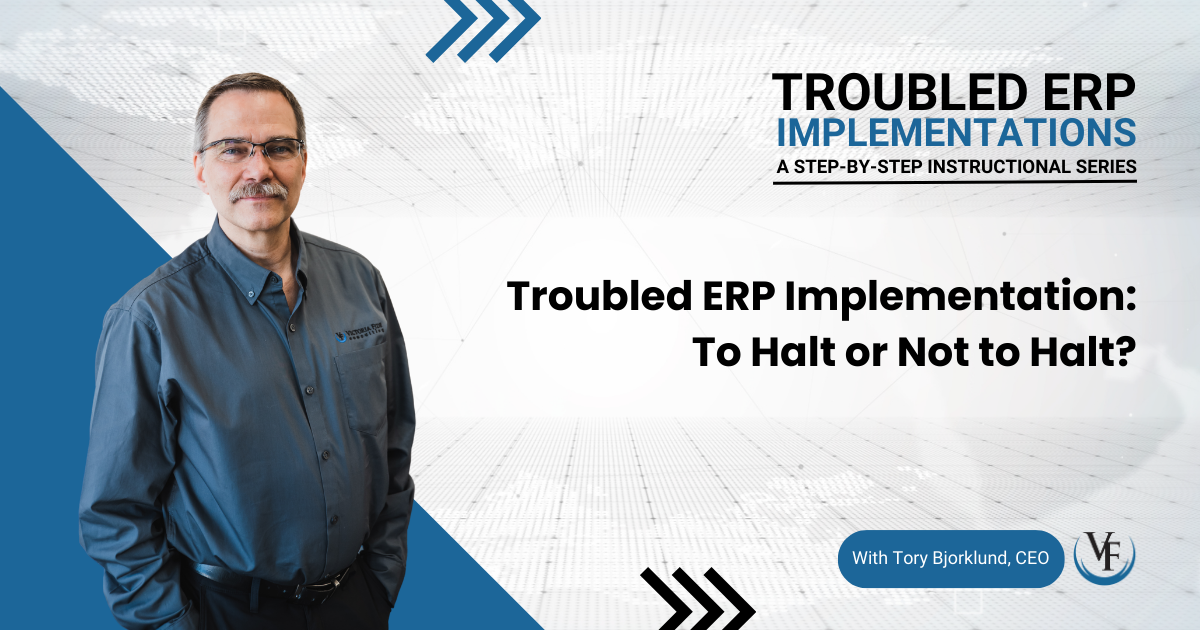
Troubled ERP Implementation: To Halt or Not to Halt?
This blog post is the third in a series on Troubled ERP Implementations. Follow us on LinkedIn to get notified of new posts.
ERP implementations are notorious for failing. You may have heard that as many as 70% of ERP system implementations fail. As someone who has been involved in many large ERP implementations, I’m surprised that the statistic is not higher. However, it is my goal to disrupt the industry standard for success and turn that statistic on its head. Why? Because I believe that change can be positive, and that success can be consistently achieved with the proper discipline applied to an effective process.
In a previous article, I laid out five steps to rescue a troubled ERP implementation, with the first step being “Stop.” In this article, I will address the top four common arguments against stopping a troubled ERP implementation and provide a fresh perspective as to why those reasons should be reconsidered.
Table of Contents
Top Areas of Resistance to Halting an ERP Implementation
I have been brought into many troubled ERP implementations to get those projects back on track. These are usually implementations that are significantly behind and over budget. Generally speaking, my first recommendation is to halt project operations on the implementation. I am surprised how often the leadership doesn’t believe we should stop current activities on the project. Here are the reasons they most often give:
- We are nearly complete and if we simply push hard enough, we can get this project over the finish line.
- If we stop now, we will have to start over again. We don’t want to lose the momentum we have.
- We have the project team in place, we don’t want to have to reconstitute the team to start again.
- We fought so hard to get where we are, we don’t want to reopen past decisions or waste time doing things we have already done.
I’d like to address each of these reasons and provide an alternative perspective.
The Finish Line Mirage: Inaccurately Measuring Project Completion
Let’s look at the first area of resistance: “We are nearly complete and if we simply push hard enough, we can get this project over the finish line.” When I hear this argument, three questions come to mind. The first is, “How do you know you are nearly complete?” My second question is, “How long have you been nearly complete?” Lastly, I ask, “Haven’t you already been pushing?”
In many instances, the project has been around 80% complete for a significant amount of time. However, the percentage completed has not increased for that same amount of time. A cynical application of the Pareto Principle (a.k.a. 80 – 20 rule) would suggest that the last 20% of the project will take four times as much effort as the first 80%. I have seen this firsthand in particularly complex implementations.
The reality is that you likely don’t know how close you are to completion, and the people who have been reporting the percentage completion have been wrong because they have been measuring completion in the wrong way.
Additionally, your team is likely demoralized and burned out from continuously pushing and have no confidence that one more push will get the project over the finish line. In fact, they either think the finish line has been constantly shifting out of reach, or they can’t see the finish line at all.
The Fear of Losing Momentum
There is an attractive intuition to the second argument: “If we stop now, we will have to start over again. We don’t want to lose the momentum we have.” Like a locomotive, it takes much less effort to keep a project operating than it is to start a project from a standstill. Starting a project involves a substantial amount of effort that is essentially administrative. This effort is directed towards managing the project but doesn’t advance the objective of the project.
I want to first address the matter of momentum. In my experience, the perceived momentum is not actual momentum. Project momentum means you are making measurable progress toward project completion. If you are not making measurable progress, you have no momentum to “keep up.” If you are not making measurable progress, continuing to push for completion will simply frustrate project participants and stakeholders.
What about the argument against starting over? There is some truth to this argument, however, it won’t be a complete restart. Much of the work done to start the project in the first place can be utilized without expending the same amount of effort if the work was done properly the first time. Additionally, there are some benefits to restarting. It gives leadership a chance to reframe the effort and focus on doing things differently rather than just trying harder the same way. It can also provide a break for the project team and help them come back reenergized to try again differently.
Cash Flow vs. Team Flow: How to Maximize ROI
“We don’t want to have to reconstitute the team to start again.” This is certainly a serious consideration. After all, it can be difficult to get the project team assembled and backfill for subject matter experts and business process owners so they can focus on the project. If they go back to the day-to-day operations, it will be difficult to free them up again to restart an implementation project. If you are using contractors, they may not be available when you need them again.
My main counterpoint is to think about the money you have been spending on these resources. Can you afford to continue paying them to sit on the bench? If the answer is no, then how can you afford to continue paying them when you are not making progress on the implementation project?
You will need a few key people to remain engaged on the reboot of the project. You don’t have to dismantle the entire team, but you should end the spend until you know how to apply that spend to the objectives of the implementation.
Yes, it will cost you money to reconstitute the team when you restart the project. However, it will not cost you as much as keeping them on a project that is not going to reach its intended conclusion.
Restarting: Building on the Past for a Fresh Start
Finally, let’s look at the last argument against halting a troubled ERP implementation: “We don’t want to reopen past decisions or waste time doing things we have already done.” Restarting the project does not mean you have to return to the starting line. If you have documented your decisions and reasons for those decisions, you don’t need to revisit those decisions. If you didn’t document those decisions, you can be sure you will have to revisit them again even if you don’t stop the project. They will most likely come up during business simulation testing or user acceptance testing.
Restarting the project will certainly lead to some initial rework. That rework will generally be around project management and governance. It doesn’t need to include requirements analysis, business process design or other work that was successfully completed during the initial implementation attempt.
At Victoria Fide Consulting, we always follow up a halt in project operations with a thorough assessment that includes the project assets that can and should be used when the project is restarted.
Why Stopping Could Prove to Be the Quickest Route to Success
In the complex and often troubling landscape of ERP implementations, hurdles and setbacks are commonplace. But understanding when to press pause can be the difference between persevering toward success or perpetuating a futile path. I hope that by addressing some common areas of resistance to stopping activities, it has given you a new perspective and uncovered the potential for a fresh beginning with a more effective approach.
Victoria Fide Consulting is committed to helping our clients make change positive by assisting you in making these difficult decisions and providing support to revitalize your ERP project. If you’re in the midst of a challenging ERP implementation or have queries about the insights shared in this article, take the next step and schedule a free 30-minute consultation with me. I would be happy to hear about your specific challenges and provide some guidance to help steer your ERP project toward a successful and sustainable finish.

Transformation is not easy, but it doesn’t have to be impossible. Take control of your project’s success today and schedule a free 30-minute consultation to find out how Victoria Fide can equip you for transformational success.
About the Author
Tory Bjorklund, a seasoned leader in the consulting, manufacturing, and software sectors, currently holds the position of CEO at Victoria Fide. With a remarkable career that spans roles such as CEO, CTO, CIO, and Chief Software Architect, Tory consistently demonstrates his bold and visionary thinking. His enthusiasm for harnessing technology to transform businesses is evident, and he fervently advocates for reshaping conventional norms in digital transformation through Making Change Positive. Connect with him on LinkedIn to follow his journey.
